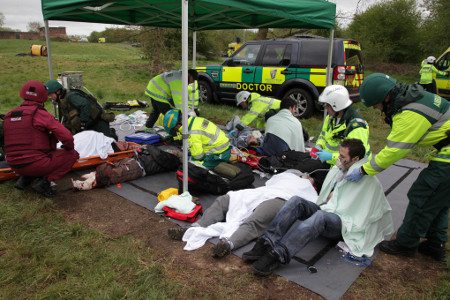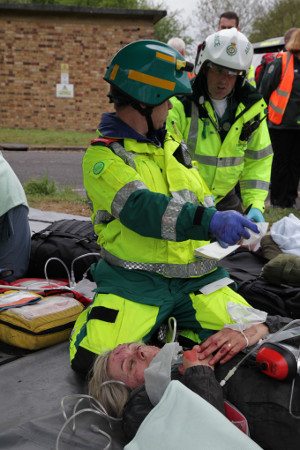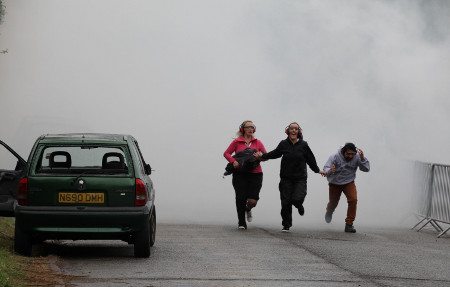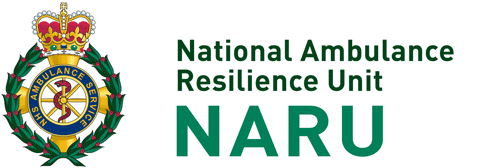 Feedback from observers at the National Ambulance Resilience Unit (NARU)-organised Exercise Amber 2 has revealed it to be one of the largest and most significant ambulance-led exercises ever held in the UK, with its success referred to by one Government department official as ‘showing interoperability at its best’.
Feedback from observers at the National Ambulance Resilience Unit (NARU)-organised Exercise Amber 2 has revealed it to be one of the largest and most significant ambulance-led exercises ever held in the UK, with its success referred to by one Government department official as ‘showing interoperability at its best’.
Exercise Amber 2 was one of the largest exercises ever undertaken by the NHS Ambulance Service on a national basis, and involved over 500 people to test the combined emergency service response to a highly complex major mass casualty incident. It took place in May 2013 at a closed army base in Staffordshire.

In addition to staff and equipment from all 10 English NHS Ambulance Services plus the ambulance service of the Isle of Wight, the military, several police forces, fire & rescue services, air ambulances and voluntary groups, Exercise Amber 2 also included around 130 people acting as ‘casualties’ at the event – most being paramedic and nursing students from regional universities in the Midlands. Almost 200 observers from various Government departments and other emergency services backgrounds attended to view the exercise.
Dr Anthony Marsh, Chair of the Association of Ambulance Chief Executives and Chief Executive of West Midlands Ambulance Service NHS Foundation Trust said:
“It is the most significant exercise that NHS ambulance services have ever conducted with our partner agencies in this country. This event was about assessing and demonstrating our joint working procedures, in making sure that in the event of a highly challenging, large scale untoward incident, the ambulance services can integrate quickly to respond effectively to treat the casualties and save as many lives as possible under the most extreme circumstances.
“Of course, we all hope that situations such as the scenario we exercised today will not happen in real life, however the reality is that as part of the emergency services we are mandated to deal with a wide variety of incidents so it is vital we are prepared.”
 Exercise Amber 2 was developed and led by the ambulance service’s National Ambulance Resilience Unit (NARU) – which is hosted by West Midlands Ambulance Service NHS Foundation Trust. It was a ‘live-play’ exercise that clearly demonstrated the complex response required by the ambulance service and their partner agencies to deal with a mass casualty incident.
Exercise Amber 2 was developed and led by the ambulance service’s National Ambulance Resilience Unit (NARU) – which is hosted by West Midlands Ambulance Service NHS Foundation Trust. It was a ‘live-play’ exercise that clearly demonstrated the complex response required by the ambulance service and their partner agencies to deal with a mass casualty incident.
Keith Prior, the National Director of NARU said:
“The feedback we have had from observers, officials within Government departments and politicians right up to the Home Secretary, has been that Exercise Amber 2 was an extremely well organised event which gave a lot of people their first real taste of what it actually means when we talk about interoperability and about emergency services organisations genuinely working together.
“As a national body delivering high quality training and exercising to the NHS, NARU was perfectly placed to run an exercise of this magnitude and we hope to be running more of these in future. The hard work and dedication of the whole team who worked on this event cannot be underestimated and I am proud they are part of my team here at NARU.”
Exercise Director David Bull, the NARU Head of Education, said:
“The Ambulance Service response capabilities for mass casualty incidents have developed significantly over the past ten years, in terms of equipment, infrastructure and staff, and it is the same for our partners in fire and police. So it is vital that we run exercises like Amber 2 with our colleagues across the emergency services spectrum, helping us really emphasise the patient as the primary focus for emergency services staff who find themselves on-scene at particularly challenging incidents. There is no doubt these exercises help us to learn more about working with each other to save lives in a dynamic and highly realistic environment and therefore help us remain better prepared if the real thing happens.”
Exercise Amber 2 provided an excellent opportunity for observers to see how all parts of the ambulance service would work together during the response to a mass casualty incident and gave observers the opportunity to get to grips with the intricacies at very close quarters, including:
- Multi agency on scene command
- Specialist response capabilities
- Patient treatment in challenging environments
- Casualty Clearing Station procedures
- Ambulance Mutual Aid and Coordination
 The Exercise follows a year on from the original Exercise Amber event which took place in London to test preparedness and resilience in advance of the Olympic Games in 2012.
The Exercise follows a year on from the original Exercise Amber event which took place in London to test preparedness and resilience in advance of the Olympic Games in 2012.
Even the paramedic and nursing students who were involved in the event acting as casualties contacted NARU afterwards to say how much it had helped them with their studies. Staffordshire Paramedic students Georgina Henry, Caroline O’Neill, Nikola Tomlinson & Kate Hawcroft wrote to say
“Thank you for such a brilliant day! We had such a great experience, one we will never have an opportunity to do again and it was all down to your kindness to allow us take part in the day. We were astonished how well the day ran, the police, fire and paramedics were all very friendly and approachable and never made any of us feel an outcast. We shared our experiences with our colleagues within the university and I cannot thank you enough for the experience and knowledge which it gave us!”
Kevin Armstrong, Course Leader of the Staffordshire University paramedic course said:
“The day was a fantastic opportunity to observe the capabilities of UK emergency services to a complex attack. This exercise demonstrated how the services, especially the ambulance service, have developed and evolved over recent years to the ever growing threat of attack on the UK. The success of the exercise is testimony to the hard work and determination of the National Ambulance Resilience Unit and partner organisations.
“The collaboration between multiple agencies seemed flawless from an observational perspective and the organisation and management of the exercise was extremely professional – members of staff from the university commented how much they enjoyed, and learned from, the experience.
“Furthermore, our students acting as casualties had the unique opportunity to see a different area of paramedic practice and the importance of communication and co-operation for complex, large scale incidents. These areas are fundamental to their development and progression to becoming competent paramedics for the future.”
About the National Ambulance Resilience Unit (NARU)
NARU was established in 2011 and works with all NHS Ambulance Trusts in England – and those in the devolved administrations – to help strengthen national resilience and improve patient outcomes in a variety of challenging pre-hospital environments.
Its work is funded by NHS England via an NHS Standard Contract with West Midlands Ambulance Service NHS Foundation Trust. Its strategy is closely aligned to the Government’s vision to modernise the health service with the key aim of securing the best possible health outcomes for patients by prioritising them in every decision it makes.
NARU provides support to the UK’s Civil Resilience and counter-terrorism (CONTEST) strategies and the Health Commitments under the UK’s National Security Strategy and the National Security Council. In addition, it supports the resilience objectives of NHS England, the Association of Ambulance Chief Executives and all Ambulance Commissioners.
